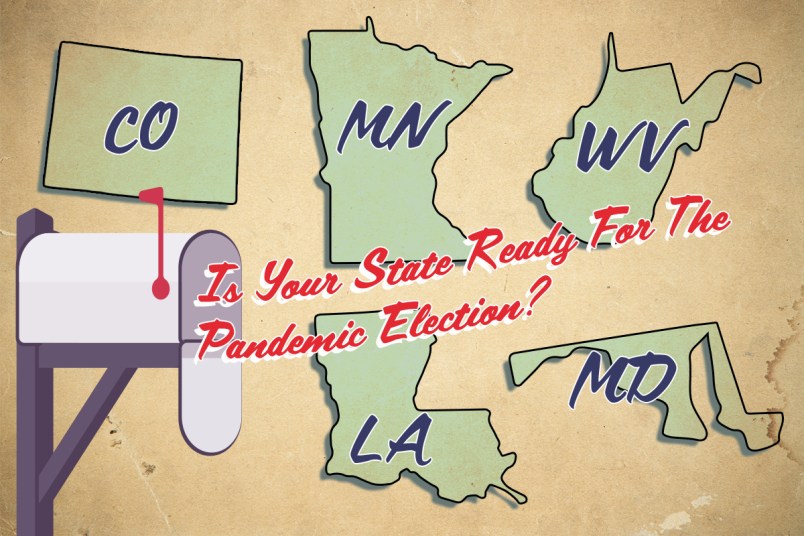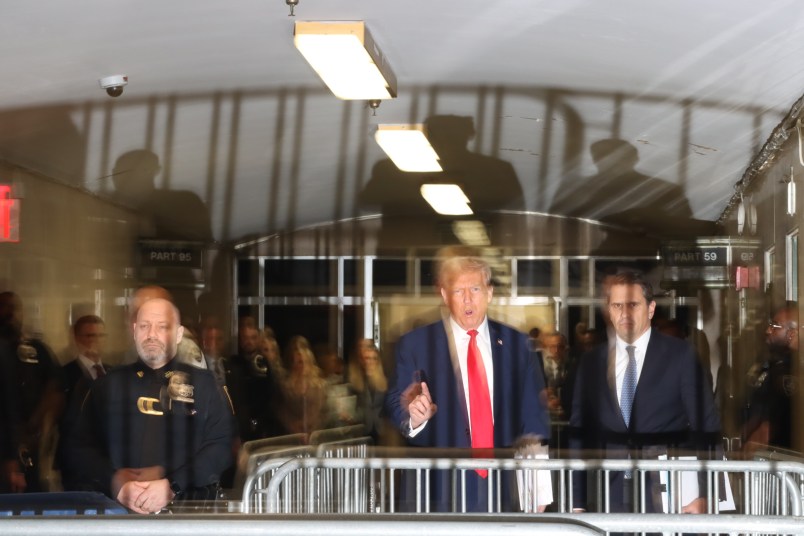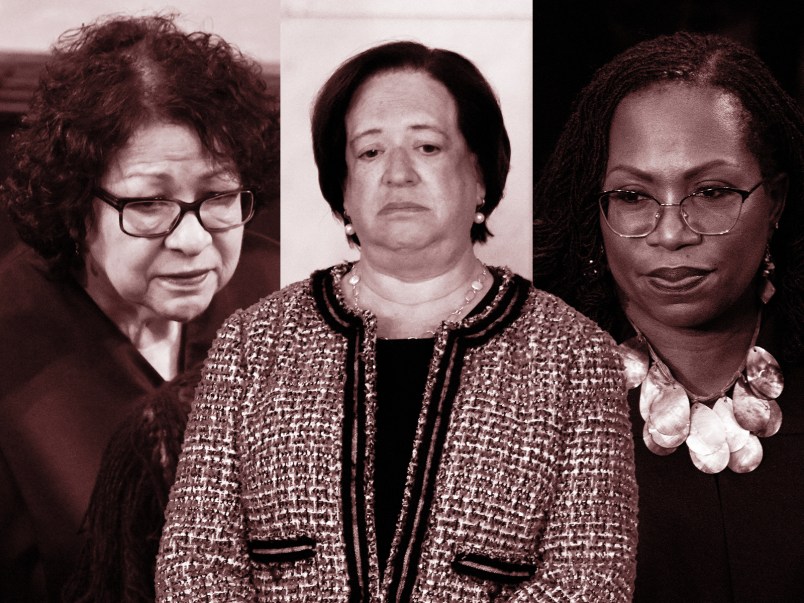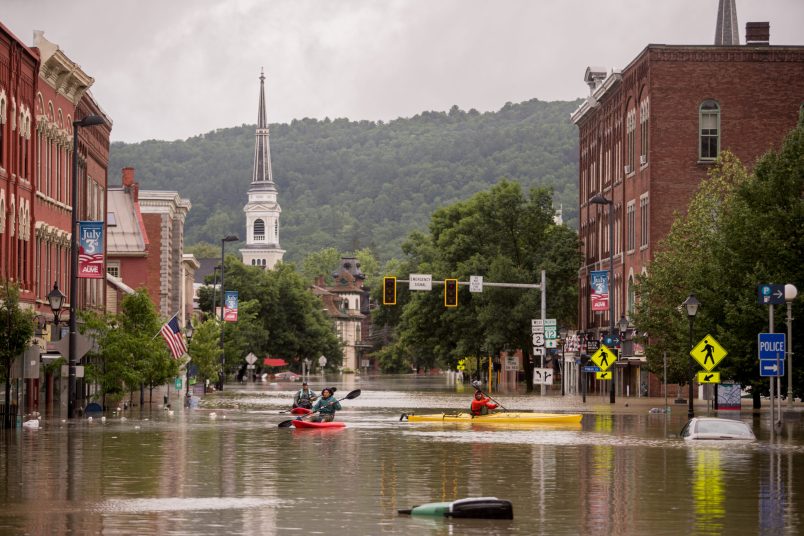Our journey through America’s varying levels of pandemic-voting preparedness continues this week with looks at Colorado, Minnesota, West Virginia, Louisiana and Maryland.
Every week, we’re looking at what states have done — or not done — to make voting easier during the coronavirus outbreak, where the fights over those moves have been the most contentious, and which states feature the kind of competitive races that could make things extra messy and volatile come November.
Here’s this week’s installment of our survey, and check out the other states we’ve examined.
Colorado
With a well established vote-by-mail program that still offers ample opportunities to cast ballots in-person, Colorado has served as the model of the type of election practices other states should consider during the pandemic.
But even the Centennial State has had a few curve balls thrown at its election preparations in recent weeks. State officials were particularly alarmed by U.S. Postal Service mailers giving voting guidance that ran afoul of Colorado’s own policies.
Colorado has had several years to perfect its mail-in voting program, and, even before the pandemic, almost all voters were submitting absentee ballots. Additionally, election officials in the state innovated the use of vote centers for in-person voting, which utilizes larger voting sites that service an entire county’s voters, regardless of their precinct. In light of the pandemic, that approach is being embraced elsewhere as well.
The state proactively mails all registered voters their mail ballots. It has several practices in place to keep voter rolls up to date, including online voter registration and automatic voter registration. Those who do not wish to turn in those ballots by mail can submit them at the voting sites where in-person early voting will be happening for at least two weeks before the election, or at other drop-off locations. Election Day registration is offered at in-person voting sites as well.
Because the election officials don’t accept any ballots — regardless of postmarks — that come in after Election Day, the state employs major education initiatives stressing that voters submit their mail-in ballots in person once they’re within eight days of an election.
This is why election officials were so perturbed by a nationwide USPS mailer giving general mail voting guidance that, according to Colorado, stood to confuse Colorado voters. In addition to its instruction for how voters should request absentee ballots (in Colorado, no request is necessary), USPS advised that seven days before an election was enough time for casting ballots by mail, cutting a day off of Colorado’s own guidance. Secretary of State Jena Griswold went to court to get USPS to stop sending the guidance.
An upshot of Colorado’s Election Day ballot receipt requirement is that the state is not expecting any major delays in reporting its results. It probably won’t deal any surprises in the presidential race, where Biden is expected to carry Colorado handily, but a Democratic takeover of the Senate depends on the defeat of GOP incumbent Sen. Cory Gardner, who’s facing off against former Gov. John Hickenlooper. Additionally, a House race where a QAnon-curious Republican candidate stands favored, but not guaranteed, to win is attracting national attention.
Minnesota
The Trump campaign has signaled it believes it can contest Minnesota this year as it tries to tip it over to their side after Hillary Clinton won it by a surprisingly narrow 45,000-vote margin in 2016. The campaign’s focus on Minnesota comes as voter fraud alarmists have also targeted the state, trying to pry various forms of voter data out of its clutches that they say would show the need for more restrictive laws. Meanwhile, Democrats are hoping to flip the state Senate, which would give them full control of the legislature and governor’s mansion.
All this means that the state with the country’s highest voter turnout rate will get extra attention for how it’s handling its election, though experienced election officials are ahead on planning for potential problems.
Take a look at how the state handled its August primary. The state faced a “tidal wave” of mail-in ballots, in the words of Secretary of State Steve Simon, which threatened to delay results and spawn legal challenges over their validity. But the state fared relatively well. It was able to sign up enough non-elderly poll workers, and was able to report results on time thanks to a state law that extended the counting period for early ballots to two weeks as a COVID-19 response measure. Furthermore, the state was helped by its voter-friendly requirements: all Minnesotans can vote by mail without needing an excuse. The state also has same-day and online voter registration, as well as extensive early voting.
But in spite of all that, problems remain. Results did take longer to be counted in some areas, in part because the state, allows mail-in ballots to be valid if they’re received up to two days after election day, so long as the envelope was postmarked by election day itself. One right-wing group is suing the state over a mask mandate at polling stations, while Secretary of State Simon has faced criticism from the right for waiving a state regulation that required absentee ballots to be signed by a witness. Early voting begins this Friday in the state, but the crucial two weeks of extra time to process will likely give the land of 10,000 lakes a leg up in reporting results on time.
West Virginia
West Virginia had very little vote-by-mail before the pandemic, but the state has taken several steps to open up the option for people who want to use it amid the coronavirus outbreak. Voters can cite COVID-19 as an excuse to vote absentee, and the state also set up an online portal for applying for a mail ballot. There is an ID requirement in the state, but its application is limited. Only first-time voters will need to provide a copy of an ID to vote absentee — and it does not necessarily have to be a photo identification — while other absentee voters can use digits from their social security numbers or DMV records to confirm their identity.
Still, there are some aspects of West Virginia’s election law that make absentee voting less accessible than it is in other states. In-person submission of mail ballots is limited to county election offices, as remote drop boxes are not permissible under state law.
Ballot collection services (what Republicans derisively call “ballot harvesting”) is also severely limited. “Although voters do not have to personally return his or her absentee ballot, no one person may deliver more than two voters’ absentee ballots,” the Secretary of State’s office advises.
Additionally, there’s not a uniform policy that’s been codified for when there are discrepancies that could cause an absentee ballot to be rejected. Local election officials are strongly encouraged by the state to reach out to voters who have issues with their absentee ballots, so that those issues can be fixed. If such contact isn’t made, then a provisional ballot is sent to those voters, which provides a backstop for getting their votes eventually counted.
Even as they expect a major surge in absentee voting, state election officials are confident that they’ll be able to maintain the normal level of in-person voting locations, thanks to a recruitment campaign for poll workers and an executive order that reduced the number of poll workers required for each location. Early in-person voting is also offered in the state.
The most notable race on the ballot is perhaps West Virginia’s gubernatorial contest. Incumbent Jim Justice — a former Democrat and billionaire who switched to the GOP in 2017 with President Trump literally at his side — is fighting off a challenge being mounted by Democratic nominee Ben Salango.
Louisiana
In Louisiana, much of November’s voting landscape turns on a lawsuit currently wending its way through the courts. The suit is an attempt by voters and groups including the Louisiana branch of the NAACP to extend for November’s general election the expanded voter access state lawmakers okayed for the July and August primaries. On Wednesday, a federal judge sided with the challengers and resurrected those measures. She ordered that the early voting period be expanded to 10 days, and that voters be allowed to vote absentee for certain COVID-19-related reasons. The decision will likely be appealed to the conservative U.S. Court of Appeals for the 5th Circuit.
The more relaxed regime for voting that was in play for the summer elections was crafted by Republican Secretary of State Kyle Ardoin, who got the support of the Democratic governor, Democratic lawmakers and a handful of moderate Republicans. But Republicans warned Ardoin then that they would not allow such broad access for the general election. Apparently heeding their warning, Ardoin in recent weeks proposed a new, much more restrictive plan that omitted absentee voting allowances for those under a COVID-19 quarantine order, at high risk of severe illness or who have symptoms. Gov. John Bel Edwards (D) called the plan “woefully inadequate” and refused to sign it. Ardoin admitted that it was “not the best plan,” but “unfortunately, it’s the best plan I thought I could get passed.” With the state government in a stalemate, the courts will ultimately decide what the fall election looks like. The clash is creating a time crunch for parish clerks who will need some latitude to expand absentee voting operations if a wider swath of voters is ultimately permitted to vote by mail.
The expansion of Louisiana’s normally strict absentee ballot excuses in the summer elections exponentially increased mail-in voter participation to 19 percent this summer in a state that usually only sees three to four percent of voters using absentee ballots.
There aren’t a whole lot of competitive races in Louisiana this cycle: President Donald Trump is a lock, and the Senate and U.S. House races are all rated as “safe” holds for the party that previously won them.
Maryland
Maryland voters, like their counterparts across the country, have spent the summer learning about new problems and on-the-go fixes.
For one thing, there aren’t enough election judges. The crowd of typically elderly poll workers has thinned in light of the COVID-19 pandemic. And as the Baltimore Sun recently reported, enthusiastic new volunteers seem to be getting lost in the bureaucratic shuffle.
That affects voting locations themselves. Rather than the typical spread of 1,600 precinct-based polling places, Gov. Larry Hogan (R) on Aug. 10 approved a plan to shift to about 360 “vote centers,” which can be utilized by anyone registered in a given county, regardless of their precinct. The State Board of Elections recommended the plan due to the staffing crunch, the Sun reported, though it’s a first for the state.
Then, in a foreboding move just last week, a ballot-printing vendor cut ties with the state, forcing them to shift the work to a different vendor less than two months before Election Day.
There’s also the U.S. Postal Service: Maryland election officials recently had to clarify for voters that a vague USPS postcard sent nationwide to give vote-by-mail advice didn’t really apply to the state.
The USPS mailer suggested voters request a ballot “at least 15 days before Election Day,” but Maryland’s deadlines are a bit tighter: Election officials must receive ballot requests by Oct. 20, and the state recommends that voters mail in their requests as soon as possible or by Oct. 15 at latest, or else just complete them online. (Voters who’ve missed the deadline can exchange request forms for ballots in-person after Oct. 20 at elections offices, The Washington Post advised.)
Ironically, the state moved up its deadline to receive mail-in ballot requests by a week — from Oct. 27 — in response to an August USPS warning that the old timeline could disenfranchise voters.
And the deadlines are more relevant now than just a few months ago. Whereas all eligible voters in the state received an actual ballot for the June primaries, this time around they’ll just get an application for one. (Between misprints, late and missing ballots, Gov. Hogan acknowledged “significant failures” with the primaries, even though mail-in voting swelled turnout in Baltimore.) Once voters have their mail ballots, as long as those ballots are postmarked by Election Day and received up to 10 days afterward, they’ll be counted. In person early voting begins Oct. 26.
Among the biggest races in the solidly Democratic (minus the GOP governor) state is the Baltimore mayoral contest, and the U.S. congressional race in the district once held by the late Rep. Elijah Cummings (D-MD).













